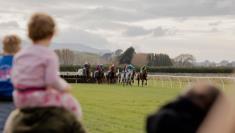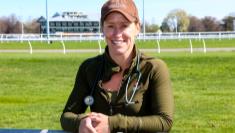Bill Hazlett: Koral and company
Bill Hazlett was a tough “Southern Man” who had an enormous impact on the New Zealand racing industry.
A Southland farmer and businessman, Hazlett, who died in 1978, was a dominant personality in a vintage era for South Island racing.
His success as an owner, trainer and breeder ensured he was an early inductee into the NZ Racing Hall of Fame.
Hazlett, who was often referred to as Big Bill, had a passion for racing – and jumpers in particular – but left a mark in variety of spheres. He was also an All Black, making his debut as a 20-year-old loose forward, farmed on a massive scale and was a leading dog trialist.
He won more than 1000 races as an owner, before any New Zealand trainer reached 1000 wins. Hazlett bred most of those winners himself, at Chelandry Stud in Southland, and also won more than 450 races as a trainer, with his own horses.
He was New Zealand’s leading owner – in terms of stake earnings - as early as 1942 and for five successive seasons from 1965 and finished in the top three a further five times.
Though operating solely as an owner-trainer, Hazlett was twice runner-up in the national trainers’ premiership, and was just one win behind Hector Anderton in the 1956-57 season. He was runner-up to Takanini trainer Fred Smith in 1948-49 and was the leading South Island trainer when third on the premiership in 1955-56.
Hazlett eventually handed over the training duties to Bill Hillis, who twice won the national premiership from his Riverton base in the 1960s, when private trainer for Hazlett.
The Hazlett-Hillis partnership was hugely successful, and the champion jumpers developed during this period include Koral, Loch Linnhe and Eiffel Tower, with Eiffel Tower also a top-class performer on the flat.
When it came to the training and riding premierships, the 1960s and 70s were a vintage period for southern horseman.
Between 1961 and 1972 Otago or Southland stables topped the training premiership 10 times, with only Eric Temperton and Syd Brown breaking the pattern.
Gore trainers Ted Winsloe and Rex Cochrane each recorded a hat-trick of wins over this period with Winsloe sharing one of his titles with Wingatui’s Hector Anderton.
Anderton, who won three premierships in all, won another title during this period and Bill Hillis’ double came in the mid-1960s.
Bill and Bob Skelton recorded 11 of their riding premierships while based in the South Island, before Bill moved north in 1964 and Bob in 1966. Between 1956 and 1969, the only year a Skelton did not take the premiership was 1964, when Wingatui jockey John Dowling topped the premiership as an apprentice.
Bill Hazlett was regarded as a tough man, in every sense of the word, but was ahead of his time in many aspects of racing and agriculture.
He originally farmed and raced horses in partnership with his brother Jack (Stuffy ) Hazlett, who was killed in action in World War II. The brothers inherited their interest in racing and farming from their father, W.T. Hazlett, who was also known as Bill.
Bill Snr established Chelandry Stud and often campaigned horses in Australia.
Bill Jnr (W.E.) expanded both the stud and racing stable and while he owned many capable flat gallopers, even the best on the flat were always regarded as potential jumpers.
Eiffel Tower won the Wellington Cup as a four-year-old and was the runner-up in both the New Zealand and Wellington Cups the following season but still had seven hurdle starts is a five-year-old.
The Hazlett team were routinely schooled over fences from an early age and Big Bill raced jumpers on a scale that only Ken and Ann Browne have come close to matching since.
Hazlett’s list of jumping wins includes 16 wins in the Great Western Steeplechase at Riverton and more than 25 feature wins at Riccarton.
The Riccarton tally included six wins in the Grand National Steeplechase, 10 in the Homeby Steeplechase and eight in the Lincoln Steeplechase, which is now known as the Koral.
There were also two Grand National Hurdle triumphs to go with six wins apiece in the Otago Hurdles and Steeplechase.
The North Island haul for the team that raced in the famous white colours with green sleeves included the Great Northern Steeplechase (3 times), Great Northern Hurdle, Pakuranga Hunt Cup, Wellington Steeplechase, Waikato Steeplechase (2), Hawke’s Bay Steeplechase (2), McGregor Grant Steeplechase, Manawatu Steeplechase (2), and the Eric Riddiford Steeplechase (2) at Trentham.
It is a full house of New Zealand’s feature steeplechases and Hazlett also notched a win in the Australian Grand National Steeplechase.
The big wins stretched over a more than 40 years, beginning with an Otago Steeplechase win in 1935, and the early Grand National wins coming in 1941 and 1943.
Loch Linnhe was the last of Hazlett’s major winners, winning both the Great Northern Steeplechase and Australian Grand National in 1976.
Koral and Eiffel Tower were both sons of Kurdistan, who stood at Chelandry. Kurdistan also sired the legendary winter performer Kumai and Melbourne Cup winner Baghdad Note, who were both trained at Wingatui.
Koral was an extraordinary jumper but his limited success in the Grand National and Great Northern Steeplechases has probably meant that he has never got the recognition his talents deserved, even though his name is commemorated in the Koral Steeplechase at Riccarton.
Koral was near unbeatable around 4000m but found the extreme distance of the Grand National and Great Northern against him, especially as he was invariably carrying big weights.
However, he still has a special place in Grand National Steeplechase history, as the youngest winner, a notable achievement in a race that has been run since 1875.
Koral, who was trained by Hillis, won the 1965 Grand National in the first week of his five-year-old season, a feat that is unlikely to be equaled. Not many six-year-olds have been successful either but four of Hazlett’s National winners won the race at that age.
Koral still had a good record in the National ‘Chase, with three seconds – the last as a 12-year-old – and a third to go with his win.
But the Homeby Steeplechase, then the main lead-up to the National, became his signature race. Koral recorded seven wins and a second from eight successive starts in the 4000m Homeby. Contesting the same feature jumping race for eight successive years is a notable achievement on its own but recording seven wins takes the feat to the next level.
The Homeby was run at the Christchurch Hunt meeting, which preceded the Grand National meeting. The National Steeplechase was then run on the first day of the carnival, with the Lincoln Steeplechase on the last day.
Koral won the Homeby, National and Lincoln in 1965. He usually beat the subsequent National winner in his later Homeby victories and added another three wins in the Lincoln.
In all, he won 25 races over fences – an astonishing number - and at the time of his retirement, in 1972, had won more money as a jumper than any other New Zealand horse.
He was at his best over the testing Riccarton fences, which were much more daunting in that period than they are now. Koral, who was always ridden by Hillis, won 12 races over the Riccarton country. He was usually aimed at the National carnival each year but was not a one trick pony. He had a win and two placings in the Hawke’s Bay Steeplechase and was twice runner-up in the Waikato Steeplechase.
Eiffel Tower won the Grand National Hurdles twice but will always be best remembered for his victory in the 1967 Great Northern Steeplechase, which is still rated as one of the most spectacular performances in the famous race.
The southern visitor ran off at the water jump early in the race, losing around 50 lengths, and was a fence behind his rivals by the time Bill Hillis had turned him back and rejoined the race. It looked like a token effort by Hillis, but Eiffel Tower steadily made up the lost ground, was in front at the top of the hill on the last round and held on to win.
Loch Linnhe, who won 25 races, was successful as a two-year-old and recorded 10 other wins on the flat, including the Riverton Cup and Great Autumn Handicap at Riccarton.
He won a hurdle at Trentham, as a four-year-old, at his jumping debut and had an outstanding record as a steeplechaser, with 11 wins from 18 attempts.
As a six-year-old he won the 100th running of the Grand National Steeplechase and returned the following winter to win the Great Western, Waikato and Great Northern Steeplechases and run third in the National.
In his final jumping preparation, he won a steeplechase at Invercargill with 76kg, giving away up to 18kg to his rivals, and the Great Western with 74kg.
He then ran third in the Waikato Steeplechase with 70kg before winning a second Northern with 69kg, the biggest weight carried to victory for 20 years. The minimum for the Northern was then 57kg, and riders could also claim, which meant Loch Linnhe was giving 13.25kg to runner-up Vitraglaze but still won by 15 lengths for amateur rider Brian Tims.
When he won his second Northern, Loch Linnhe was in the temporary care of Cambridge trainer Jack Winder, who also took the horse to Melbourne, where Loch Linnhe won both his starts including the Australian Grand National with 71kg.
It was almost 40 years before another horse won the Australian Grand National with more weight. That was when Bashboy carried 72.5kg, off a 64kg minimum, in 2013.
Witness the next chapter of jumps racing history unfold this season. Head to loveracing.nz/lovejumps to find a jumps raceday near you.









